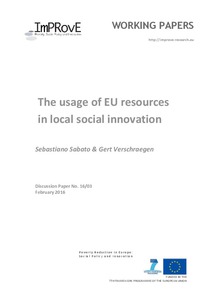The usage of EU resources in local social innovation
"Over the last few decades, the European Union (EU) has made available a number of resources for promoting and supporting social innovation in the field of poverty and social exclusion (cf. Sabato et al. 2015). These resources include, most obviously, funding but also networking opportunities,...
| Main Authors: | , , |
|---|---|
| Institution: | ETUI-European Trade Union Institute |
| Format: | TEXT |
| Language: | English |
| Published: |
Antwerp
2015
ImPRovE |
| Subjects: | |
| Online Access: | https://www.labourline.org/KENTIKA-19106267124919244499-The-usage-of-eu-resources-in-l.htm |
| Summary: | "Over the last few decades, the European Union (EU) has made available a number of resources for promoting and supporting social innovation in the field of poverty and social exclusion (cf. Sabato et al. 2015). These resources include, most obviously, funding but also networking opportunities, cognitive resources, visibility and reputational resources. This paper investigates a) how resources provided by the European Union (EU) have been used in socially innovative initiatives implemented at the local level, b) what has been their added value and c) which difficulties local actors have encountered when accessing and using these resources. Our study is based on the analysis of sixteen socially innovative initiatives implemented in five Member States (Austria, Belgium, Italy, Sweden and the UK) and concerning three policy areas: Roma inclusion (notably, education-related initiatives), homelessness and housing exclusion (Housing First), and labour market activation. A number of conclusions can be drawn from our analysis. First, the EU level appears as a key layer of multi-scalar social innovation systems, often able to directly sustain local projects, bypassing the national level. Indeed, EU resources – especially financial and cognitive resources – have been used in most of our case studies and have often been deemed essential for the implementation of those projects. Second, in a number of cases EU resources have been strategically used by local actors in order to implement initiatives at odds with established domestic policy legacies, i.e. for experimenting with either new policy approaches or new instruments/methods within established approaches. We call this the leverage effect of EU resources. Third, the various welfare regimes are characterised by different social innovation patterns, especially in relation to institutionalization and up-scaling dynamics: welfare regime-related peculiarities can be identified, also when it comes to using EU resources for such purposes. While countries belonging to Universalistic and (in part) Corporatist welfare regimes appear particularly able in using EU resources to experiment with innovative initiatives, then mainstreaming successful projects into public policies once the EU co-funding period expires, this capacity appears much more limited in countries belonging to Familistic and Liberal welfare regimes. Fourth, EU resources have, remarkably enough, not been used for up-scaling socially innovative initiatives in any of our cases, even though the EU emphasizes that resources are also intended to be used for this. Finally, a number of shortcomings which make access to EU resources and their management difficult have been identified, including complex and time-consuming procedures related to EU funds and the inadequacy of the support provided by public bodies. These shortcomings often limit small organisations’ ability to exploit EU resources, thus contributing to the creation of a ‘frozen’ situation where big and well-established organisations – which have developed expertise and experience in dealing with EU resources – enjoy a sort of incumbents’ advantage." |
|---|---|
| Physical Description: | 52 p. Digital |

